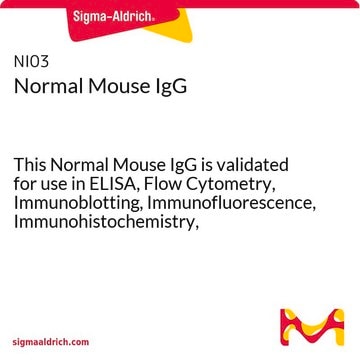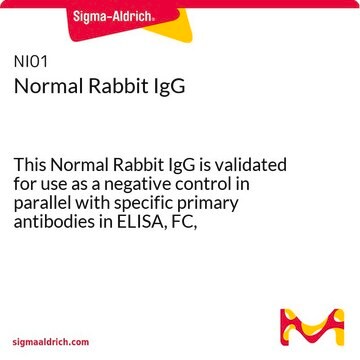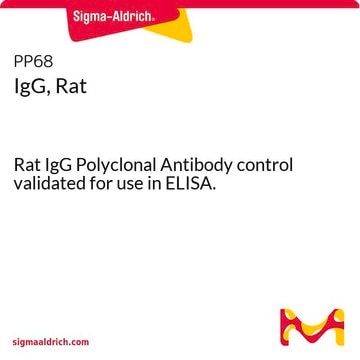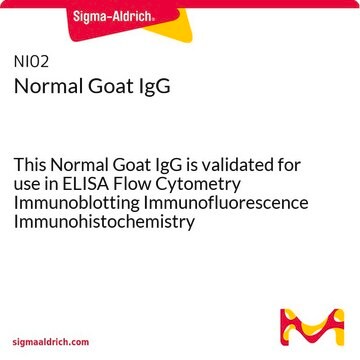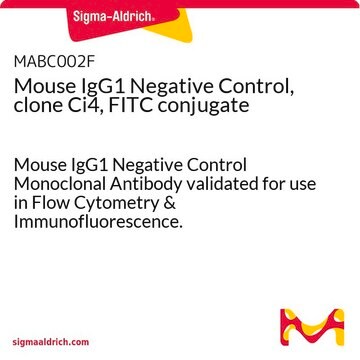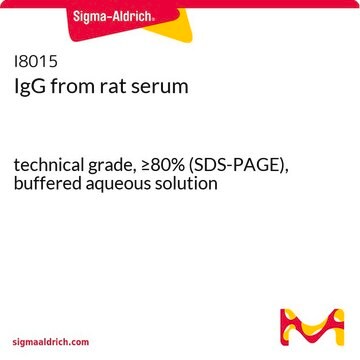12-371
Normal Mouse IgG
Normal Mouse IgG Polyclonal Antibody control validated for use in Immunoprecipitation & Western Blotting.
Synonym(s):
Mouse IgG Antibody
Sign Into View Organizational & Contract Pricing
All Photos(1)
About This Item
UNSPSC Code:
12352203
eCl@ss:
32160702
NACRES:
NA.41
Recommended Products
biological source
mouse
Quality Level
conjugate
unconjugated
antibody form
purified immunoglobulin
clone
polyclonal
manufacturer/tradename
Upstate®
concentration
1 mg/mL
technique(s)
immunoprecipitation (IP): suitable
western blot: suitable
isotype
IgG
shipped in
wet ice
target post-translational modification
unmodified
General description
Immunoglobulin G (IgG), is one of the most abundant proteins in human serum with normal levels between 8-17 mg/mL in adult blood. IgG is important for our defence against microorganisms and the molecules are produced by B lymphocytes as a part of our adaptive immune response. The IgG molecule has two separate functions; to bind to the pathogen that elicited the response and to recruit other cells and molecules to destroy the antigen. The variability of the IgG pool is generated by somatic recombination and the number of specificities in an individual at a given time point is estimated to be 1011 variants.
Normal mouse IgG was isolated from pooled normal mouse serum by fractionation and ion-exchange chromatography.
Normal mouse IgG was isolated from pooled normal mouse serum by fractionation and ion-exchange chromatography.
Application
Research Category
Secondary & Control Antibodies
Secondary & Control Antibodies
Research Sub Category
Whole Immunoglobulin Secondary Antibodies
Whole Immunoglobulin Secondary Antibodies
Quality
Routinely evaluated by IP/WB as a negative non-specific IgG control.
Immunoprecipitation/Western Blot Assay:
4 µg of this lot was used as a negative non-specific IgG control in an immunoprecipitation/western blot assay.
Immunoprecipitation/Western Blot Assay:
4 µg of this lot was used as a negative non-specific IgG control in an immunoprecipitation/western blot assay.
Physical form
Purified mouse IgG in buffer containing 0.1 M Tris-glycine, pH 7.4, 0.15 M NaCl, 0.05% sodium azide containing 30% glycerol. Liquid at -20°C.
Storage and Stability
Stable for 1 year at -20°C from date of receipt.
For maximum recovery of product centrifuge the original vial prior to removing the cap. Handling Recommendations: Upon first thaw, and prior to removing the cap, centrifuge the vial and gently mix the solution. Aliquot into microcentrifuge tubes and store at -20°C. Avoid repeated freeze/thaw cycles, which may damage IgG and affect product performance. Note: Variabillity in freezer temperatures below -20°C may cause glycerol containing solutions to become frozen during storage.
For maximum recovery of product centrifuge the original vial prior to removing the cap. Handling Recommendations: Upon first thaw, and prior to removing the cap, centrifuge the vial and gently mix the solution. Aliquot into microcentrifuge tubes and store at -20°C. Avoid repeated freeze/thaw cycles, which may damage IgG and affect product performance. Note: Variabillity in freezer temperatures below -20°C may cause glycerol containing solutions to become frozen during storage.
Legal Information
UPSTATE is a registered trademark of Merck KGaA, Darmstadt, Germany
Disclaimer
Unless otherwise stated in our catalog or other company documentation accompanying the product(s), our products are intended for research use only and are not to be used for any other purpose, which includes but is not limited to, unauthorized commercial uses, in vitro diagnostic uses, ex vivo or in vivo therapeutic uses or any type of consumption or application to humans or animals.
Storage Class Code
10 - Combustible liquids
WGK
WGK 1
Certificates of Analysis (COA)
Search for Certificates of Analysis (COA) by entering the products Lot/Batch Number. Lot and Batch Numbers can be found on a product’s label following the words ‘Lot’ or ‘Batch’.
Already Own This Product?
Find documentation for the products that you have recently purchased in the Document Library.
Customers Also Viewed
Regulation of CCL2 expression by an upstream TALE homeodomain protein-binding site that synergizes with the site created by the A-2578G SNP.
Page, SH; Wright, EK; Gama, L; Clements, JE
Testing null
Heterogeneity of estrogen receptor expression in circulating tumor cells from metastatic breast cancer patients.
Babayan, A; Hannemann, J; Spotter, J; Muller, V; Pantel, K; Joosse, SA
Testing null
Argonaute 2 complexes selectively protect the circulating microRNAs in cell-secreted microvesicles.
Li, L; Zhu, D; Huang, L; Zhang, J; Bian, Z; Chen, X; Liu, Y; Zhang, CY; Zen, K
Testing null
Vanesa Nogales et al.
Oncotarget, 7(3), 3084-3097 (2015-12-02)
Platinum-derived drugs such as cisplatin and carboplatin are among the most commonly used cancer chemotherapy drugs, but very few specific molecular and cellular markers predicting differential sensitivity to these agents in a given tumor type have been clearly identified. Epigenetic
Guangdong Sun et al.
Journal of the American Society of Nephrology : JASN, 21(12), 2069-2080 (2010-10-12)
TGF-β1-induced expression of extracellular matrix (ECM) genes plays a major role in the development of chronic renal diseases such as diabetic nephropathy. Although many key transcription factors are known, mechanisms involving the nuclear chromatin that modulate ECM gene expression remain
Our team of scientists has experience in all areas of research including Life Science, Material Science, Chemical Synthesis, Chromatography, Analytical and many others.
Contact Technical Service
